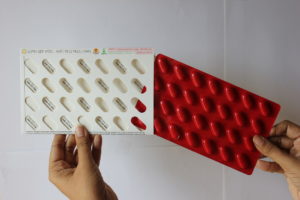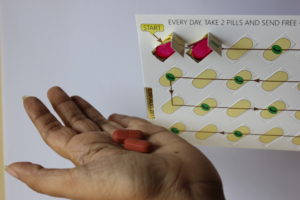Tuberculosis (TB) affects approximately 2 million persons in India and out of them, 2.2 lakh dies annually! The Revised National Tuberculosis Control Programme (RNTCP) has been in place since 1997 and yet, the efficacy of the directly observed treatment short-course (DOTS) doesn’t seem to be proving any good. The only question there being, whether the “free” treatment is actually directly observed or not!
The DOTS provider is the person who is assigned to supply the free anti TB medicines to the patient and the patient has to take the medicine in their presence, there by making it a directly observed therapy. But, this doesn’t happen all the time. It has become even more difficult now that the DOTS is given daily and not on alternate days.
From February 1, 2018 there has been a new initiative to make the monitoring of DOTS a little better and this article is about that system, which you might have already heard as the 99 DOTS.
What is 99 DOTS?
99 DOTS is a new scheme of providing the free anti-TB medicines. The medicines are placed in a special envelope which when peeled reveals a phone number. Each time the patient takes the medicine, he or she has to dial the phone number found inside the medicine envelope.
The patient has to dial this number from their own registered phone and the best thing is that these calls are toll free! Not a single paisa is deducted from the patient’s phone balance. On making this call, they’ll just hear a “Thank You” from the other side and that’s it.
Different numbers are printed on each envelope and it’s hard for patients to guess the numbers. Now, the patient’s phone number is saved along with 5 other phone numbers of those who are supposed to monitor the adherence of this patient’s DOTS. These other 5 persons could be the DOTS provider, concerned area junior health inspector, pharmacist of the PHC or CHC, medical officer of the PHC/CHC, medical officer of the TB unit and the District TB officer. If the patient fails to do this on a particular day, SMS alerts are sent to the monitoring official’s phone numbers and the patient will receive reminder calls and texts to take the medicine. If the patient dials the right number every day from his/her phone, it is assumed that the patient has taken the medicine for that day!

99 DOTS was earlier used to monitor the adherence of TB patients who were retro virus positive. By spreading the use of this novel scheme to all the TB patients, the control of this deadly disease in India can reach it’s goal shortly.
By strictly following 99 DOTS, 99% cure rate can be achieved which is really impressive and that’s what India needs now in it’s battle against TB. With almost all the patients owning a mobile phone nowadays, this scheme will definitely be a turning point in Indian healthcare system.
How is 99 DOTS different?
In the first two months of DOTS, the patient is required to come to the DOTS centre and collect the medicine and then take it before leaving the centre. For patients who are weak and bed-ridden, the DOTS provider, preferably an ASHA or Anganwadi teacher will supply the medicine to the patient’s home where he/she has to take it in their presence. Now this doesn’t happen all the time!
Relatives or friends of the patient will collect the medicine from the DOTS centre and give it to the patient who either forgets to consume the medicine or skips it conveniently due to unknown reasons! When this happens for more than 2 days, the adherence of the patient to the DOTS decreases. They think that there’s no harm in skipping the medicines regularly and makes it a routine. This can lead to treatment failure and the patient who was initially on Category I of the DOTS will have to start over again and this time in Category II which has intra-muscular injections in the course and lasts for 9 months instead of 6!

Unless the patient had taken the medicines under direct supervision of the DOTS provider, there was no real way to monitor the DOTS earlier and 99 DOTS comes into play here.
In the second phase of the DOTS called as the continuation phase, the medicines are given for one full week to the patient. This phase which extends from the second to sixth month (4 months) is the most crucial time when adherence to the DOTS is lost. 99 DOTS can tremendously help patients to keep their focus and continue to take the medicine in this phase. For patients who forget to take the medicines, this scheme will be a real boon, not just for them, but for the whole community!
Advantages of 99 DOTS
- Patient doesn’t have to incur any additional expense as the calls made to these special numbers are absolutely toll free
- As the whole data is collected and stored in online servers, the analysis is super easy and very powerful. This data of adherence can be used by providers and health officials to spend more time and effort on those patients who need help and support to complete the full course of DOTS.
- Almost all TB patients have phones and thus more and more patients can be enrolled in 99 DOTS and thus increasing it’s usability
- Once a patient is interacting with 99 DOTS, it’s possible to add other helpful services to improve adherence, including daily reminders, incentive structures, or custom-tailored medical advice or counseling if a patient needs.
- A large spectrum of numbers are used in the medicine envelopes which makes it impossible for the patients to predict the number that has to be dialled each day. This means that the patient has to dispense the medicine to get the phone number to be dialled and there’s no escape from that.
Final Thoughts
99 DOTS is a big step to India’s tuberculosis control programme and it’s already launched now. Tuberculosis is a vast topic and is beyond the scope of this article. I’m not saying that the 99 DOTS is a foolproof system which has no loopholes! At our PHC, the first patient who got registered under the 99 DOTS is an inmate of a shelter home and she doesn’t even have a mobile phone! We did register that patient by giving more responsibilities to the DOTS provider and the charge officer of the shelter home.
Now you know that there’s this new system of tracking the adherence of DOTS taking patients and it’s based on technology and that it’s better than the current system. When the government starts giving incentives to all TB patients, this scheme will become more popular for sure. It’ll take more time and work for India to control TB and 99 DOTS is the right road to it.
So, if you liked this new scheme, do send in your comments below.